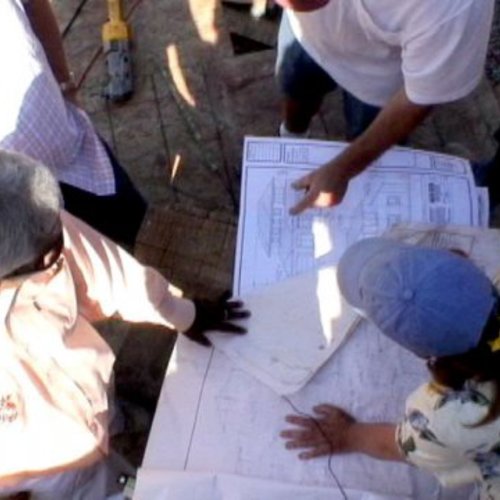
Image Credit: Packer Industries
A big part of building green is managing the job site’s “tailpipe.” What you throw out on a job can say an awful lot about overall project management, from your scopes of work to budgeting to job site practices.
Know what you throw
The first step in developing a waste management plan that will work is to do some job site waste audits. If the projects you do vary widely in type (gut rehab vs. new construction vs. weatherization vs. kitchens), do at least one of each type. Your waste audit can be based on weight or volume estimates; your choice is likely to depend on how you are charged for waste.
Assess opportunities for waste diversion
This is almost always the hardest step. No expert can tell you what outlets there are for your metals, cardboard, clean wood, or gypsum board. Often you need to check with your local green building program, local solid waste coordinator, or simply start working the yellow pages. Quite often, finding the first outlet or nugget of recycling or reuse information will result in a chain of connections for other materials or methods of waste diversion or recovery.
Develop a plan
Your overall waste management plan is likely to involve waste reduction, reuse, recycling, and safe disposal of both inert and hazardous or controlled wastes. Then pieces of the plan need to be incorporated into your individual trade contractor scopes of work or contracts. As you are developing this plan, remember that any waste generated on any of your projects essentially has your name on it, in terms of ultimate liability. If you think proper disposal or recycling seems expensive, consider the alternative of legal liability.
The best resources
Although a bit dated, I still think that these two guides are among the most straightforward and helpful with the three steps listed above:
Residential Construction Waste Management: A Builder’s Field Guide
Waste Management and Recovery: A Field Guide for Residential Remodelers (in two pdfs – www.epa.gov/osw/conserve/rrr/imr/cdm/pubs/remcover.pdf and www.epa.gov/osw/conserve/rrr/imr/cdm/pubs/remguide.pdf)
Also, see this previous ECP blog on Deconstruction.
Give and take
The Enterprise Green Communities criteria checklist requires a waste management plan that reduces waste by at least 25% (6.1). So let us know what your waste management details are or ask fellow GBAers to help out with your questions/problems—fire away!
Weekly Newsletter
Get building science and energy efficiency advice, plus special offers, in your inbox.















3 Comments
Single-stream construction recycling
We have a for-profit single-stream waste recycling facility near Charlottesville, Virginia (http://vanderlinderecycling.com/) that has been up and running for the past 2 years. It's a big hit with builders because it actually costs less than sending waste to the landfill, the builders get credit for recycling and they don't have to do anything differently...they can still just put everything in the dumpster. The facility uses a $10 million sorting machine and ~15 people to sort the waste. They reportedly get about a 90% recycling rate. I hear the remaining 10% goes to a combined heat + power (CHP) plant in Harrisonburg, VA that produces steam for James Madison University's chillers and electricity for the Harrisonburg municipal electric utility.
The service recently started accepting household waste, and will hopefully put our landfills out of business in the next few years.
Single-stream C&D recycling
Very interesting--thanks for sharing this info.
Back in 1991 when I was working on my Master's thesis on this topic, the rule of thumb in the waste industry was that commingled or single-stream recycling of C&D waste was not economically feasible unless tipping fees for disposal were at least $50 per ton. And lo and behold, tipping fees at Vanderlinde are $49 per ton for C&D materials.
Certainly takes a lot of pressure off of jobsites if someone else, someplace else, separates out the "wheat from the chaff."
Commercial LEED Providers
If you're fortunate enough to live in a larger metro area where commercial LEED projects are fairly common, then you are almost assured of having a for-profit, commingled provider exactly as John describes. Basically, if the C&D haulers wanted to continue to play in that commercial arena, they have had to move to this model or get passed over for the bigger contracts. However, just because they changed / developed their model for the commercial sector, most of them are very willing to work with residential contractors too since they're happy to have any business they can get these days. So, leverage that to your advantage.
If you don't have one of those services in your market, there may be another option. Before we had such a service, I negotiated a deal with our hauler where they would either give us two 15 yard containers for the cost of a single 30 or they would give us two 20 yard units for the same cost as a single 40. With business being tight and lots of empty containers sitting in their yards, this wasn't a very hard deal to get them to accept.
With the two smaller boxes the foot print on the job site was the same so we didn't need any extra space and our cost was also the same for budgets and bidding. However, we would clearly mark one with a banner (from the local sign shop) which designated it as the "paper, plastics & metal" unit. (This had an added PR benefit for the neighbors and passers-by of our sites). The trades were instructed to toss their trash accordingly, and if they didn't, they got to go dumpster diving! That usually only had to happen once before they got on board :-)
Log in or create an account to post a comment.
Sign up Log in